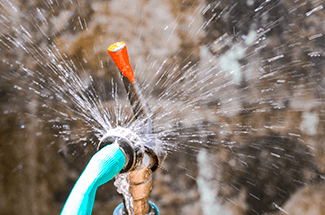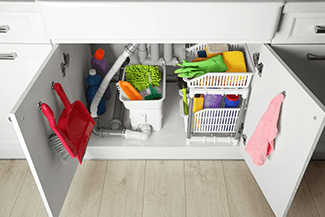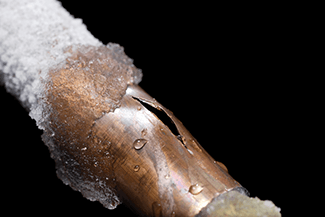How To Stop Your Pipes From Freezing In The Winter
There isn’t anywhere in Arizona you can go where pipes are not susceptible to freezing. In many parts of the state, the likelihood of pipes freezing is very low. However, in January 2007, Yuma saw a temperature of 13 degrees Fahrenheit. That is highly unusual over there. That temperature will surely freeze a pipe!

The National Weather Service published the first and last recorded freeze dates in Arizona. Some of them surprised us.
No one wants to deal with frozen pipes. So, let’s look at ways to mitigate such an occurrence.
Protect Your Plumbing
Most of us who live in our homes full time don’t have to do much to protect our indoor piping. By keeping the household temperatures above freezing, the internal piping is safe. However, the water lines to your home, either well, municipal or privately supplied, may need additional attention. This is very true in our colder and more rural climates.
Start by inspecting your supply lines. If there is any portion of the pipe that is visible, you will need to wrap it with insulation such as these:
- Fiberglass
- Foam
- Mineral Wool
- Polyisocyanurate
- Phenolic
Each of these has good insulating characteristics. They all need protection from the weather, though. Moisture, sunlight, insects, and critters can break the product down and render its insulating qualities useless. Wrapping the insulation in a UV-resistant plastic, metal such as aluminum sheets used for flashing, and concrete, all work at adding protection to the insulation as it protects the pipe from freezing.

An often-overlooked pipe is the landscape irrigation line. The portion of some lines that extend from the source of water (such as an exterior hose bib), if not protected, can be vulnerable to freezing. There are specific products made to address these conditions.
Thousands of us enjoy a cabin or second home in the mountains of Arizona. Steps need to be taken to winterize that home. Because you will probably not leave the temperature at 50 to 55 degrees for the several months you are gone, things will freeze. Shutting off the water supply at its source is step one. You will need to drain the lines in your home of all water. This includes the toilet tanks. Every item in your home with a drain has a P-trap formed in the line that traps the water to prevent sewer gasses from entering the home. Because you cannot get to all these, you will need to pour a special anti-freeze into each drain and toilet. Use an anti-freeze called “RV anti-freeze.” These products are available at most hardware stores. Do not use regular automotive anti-freeze, as this can damage the pipes.
Although you did your best to protect the pipes, somehow, you managed to miss a spot.
My pipes are frozen! Now what?
Despite your best efforts, pipes can still freeze.

A common location of frozen lines is under sinks adjacent to an outside wall of the house. The cabinet doors are closed, and particularly in older homes, exterior wall insulation might be sparse, causing the pipes below the sink to freeze. Opening the cabinet doors and exposing the pipes to the warmth of the home might do the trick. Adding a space heater outside the cabinet might help as well.
Caution: Never place a space heater under a cabinet. There are too many opportunities for a fire to ignite.
Crawl spaces are another location where a pipe might freeze. Unless you can monitor a temporary heat source, such as a space heater, don’t use one. If there is an access door from inside the home, open it and expose the space to the heat from the house. You might have to wait this one out.
Exposing the pipes to a heat source that does not involve an open flame is your best course of action. A hairdryer is a common temporary source of heat. Do NOT use anything with an open flame exposed to the pipe. A plastic pipe you can see melting, but you can’t see the potential structural damage you might cause to a metal pipe. And, catching the house on fire is never a good way to thaw your pipes, either.
Slowly letting the heat get to the pipe is the safest way to thaw them.
Caution: Only use a space heater when you are home! Never leave a space heater unattended.
Yay, my pipes thawed! OH NO! My pipes thawed!
What? Thawing the pipe is the goal here, right? The short answer is yes. There is a potential problem, though. After the pipe thaws, there is still work to be done. When water freezes, it expands. Typically, it will increase its volume by 9%, according to my 10th-grade earth sciences teacher.

When water freezes in a pipe, it can expand two ways, along the space in the pipe or outwardly. The outward expansion can crack a pipe (think pipe burst). Tiny pinholes and visible cracks will cause water to leak once it thaws. If you have a good idea where the pipe froze, great. As it thaws, keep a watchful eye on it for a possible leak.
If you are not sure where the pipe froze, then after the water starts to flow again, you will need to inspect all the piping you can to check for leaks. Listen for a hissing sound or water flowing behind a wall. If your water system is metered, and you are not seeing any signs of leaking, check the meter by turning off all faucets and see if the meter is still running. If you are on a well, turn everything off. If the well pump is still running after the tank is filled, you may have a problem.
Frozen pipes are no fun, nor are they an event to be ignored once the water starts up again.
###
PODCAST
Our Weekly To Do on ways to mitigate pipe freezes. A listener thinks he has a vapor lock issue in his hot water piping system. We call in a lifeline from Day And Night Plumbing for some answers. Plus other questions on damaged tile in a sunken patio and a air conditioner condensate leak solution before the warranty runs out.
Podcast Archive With Expanded Content and Resources
PHOTO CREDIT
- Shutterstock















